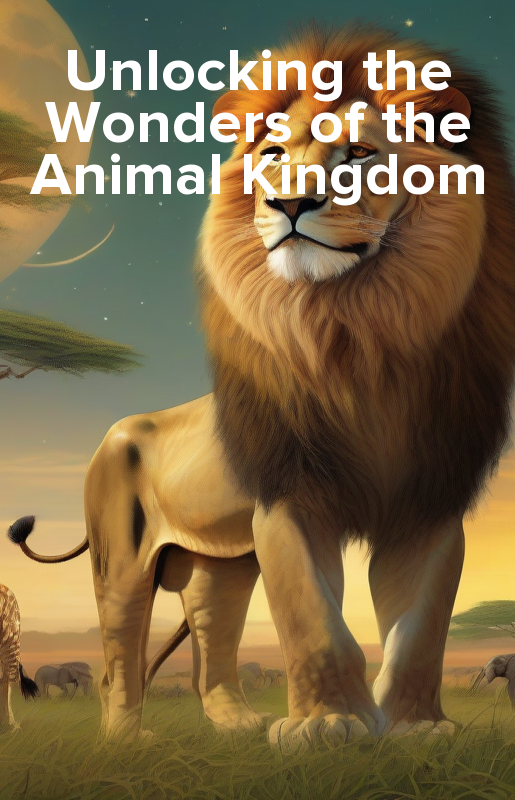Table of contents for ebook and audiobook: „Unlocking the Wonders of the Animal Kingdom”
Here's the translation to English:
The Animal Kingdom: A Comprehensive Guide
Part 1: Introduction to the Animal Kingdom
Chapter 1: The Diversity of Animals
- 1.1: Definition and Classification of Animals
- 1.2: The Six Kingdoms of Life: Protists, Fungi, Plantae, Animalia, Monera, and Chromista
- 1.3: Characteristics of Animals: Multicellularity, Sensitivity, and Movement
- 1.4: The Importance of Animals in Ecosystems
- 1.5: Threats to Animal Populations: Habitat Loss, Pollution, and Climate Change
Chapter 2: Animal Evolution and History
- 2.1: The Origin of Life on Earth: Theories and Evidence
- 2.2: The Emergence of Animals: From Single-Celled Organisms to Complex Life Forms
- 2.3: Major Transitions in Animal Evolution: From Water to Land, and from Simple to Complex Body Plans
- 2.4: The Rise of Vertebrates: Fish, Amphibians, Reptiles, Birds, and Mammals
- 2.5: The Impact of Human Activity on Animal Evolution
Part 2: Animal Structure and Function
Chapter 3: Body Systems and Organs
- 3.1: The Nervous System: Structure, Function, and Disorders
- 3.2: The Circulatory System: Heart, Blood, and Blood Vessels
- 3.3: The Respiratory System: Lungs, Trachea, and Bronchi
- 3.4: The Digestive System: Mouth, Esophagus, Stomach, and Intestines
- 3.5: The Excretory System: Kidneys, Urinary Bladder, and Ureters
Chapter 4: Senses and Perception
- 4.1: The Eye: Structure, Function, and Disorders
- 4.2: The Ear: Structure, Function, and Disorders
- 4.3: The Nose and Sense of Smell
- 4.4: The Tongue and Sense of Taste
- 4.5: The Skin and Sense of Touch
Chapter 5: Movement and Locomotion
- 5.1: The Skeletal System: Bones, Joints, and Muscles
- 5.2: The Muscular System: Types of Muscles, Muscle Contraction, and Relaxation
- 5.3: Movement and Locomotion: Walking, Running, Swimming, and Flying
- 5.4: Balance and Coordination: The Role of the Inner Ear and Cerebellum
- 5.5: Animal Migration Patterns: Endurance, Navigation, and Social Behavior
Part 3: Animal Behavior and Sociality
Chapter 6: Animal Behavior: Learning, Memory, and Communication
- 6.1: Types of Learning: Classical Conditioning, Operant Conditioning, and Insight Learning
- 6.2: Memory and Forgetting: Short-Term and Long-Term Memory
- 6.3: Animal Communication: Vocalizations, Body Language, and Chemical Signals
- 6.4: Social Learning: Observational Learning and Cultural Transmission
- 6.5: Animal Problem-Solving: Tool Use, Innovation, and Adaptation
Chapter 7: Sociality and Cooperation in Animals
- 7.1: Types of Sociality: Solitary, Pair-Bonded, and Group-Living Animals
- 7.2: Cooperative Breeding: Altruism, Reciprocity, and Kin Selection
- 7.3: Social Hierarchy and Dominance: Rank, Status, and Conflict
- 7.4: Animal Friendships: Affiliative Behavior and Bonding
- 7.5: Cooperative Foraging and Hunting: Shared Resources and Mutual Benefit
Chapter 8: Animal Sociality and Human Culture
- 8.1: The Evolution of Human Sociality: Cooperation, Altruism, and Culture
- 8.2: Animal Influences on Human Culture: Domestication, Companion Animals, and Zoos
- 8.3: The Impact of Human Activity on Animal Sociality: Habitat Fragmentation, Pollution, and Climate Change
- 8.4: Conservation and Management of Animal Populations: Human-Animal Conflicts and Coexistence
- 8.5: The Future of Animal Sociality: Emerging Trends and Challenges
Part 4: Conservation and Management of Animal Populations
Chapter 9: Threats to Animal Populations: Habitat Loss, Pollution, and Climate Change
- 9.1: Deforestation and Habitat Fragmentation: Causes, Consequences, and Conservation Efforts
- 9.2: Pollution and Its Impact on Animal Populations: Chemicals, Noise, and Light Pollution
- 9.3: Climate Change and Animal Populations: Impacts, Adaptations, and Conservation Strategies
- 9.4: Human-Animal Conflicts: Causes, Consequences, and Mitigation Strategies
- 9.5: Animal Migration and Dispersal: Barriers, Corridors, and Conservation Efforts
Chapter 10: Conservation and Management of Animal Populations
- 10.1: The Importance of Conservation Biology: Protecting Biodiversity and Ecosystem Services
- 10.2: Conservation Strategies: Habitat Protection, Species Management, and Community-Based Conservation
- 10.3: Animal Reintroduction Programs: Successes, Challenges, and Future Directions
- 10.4: Human-Wildlife Conflict Mitigation: Deterrents, Compensation, and Community Engagement
- 10.5: The Future of Animal Conservation: Emerging Trends, Challenges, and Opportunities
Part 5: Conclusion and Future Directions
Chapter 11: The Future of the Animal Kingdom
- 11.1: Emerging Trends in Animal Research and Conservation
- 11.2: The Impact of Human Activity on Animal Populations: Past, Present, and Future
- 11.3: Conservation and Management of Animal Populations: Successes, Challenges, and Future Directions
- 11.4: The Role of Science and Society in Animal Conservation: Collaboration, Education, and Policy
- 11.5: The Future of Animal Welfare: Emerging Trends, Challenges, and Opportunities

